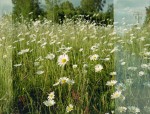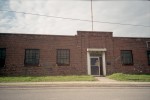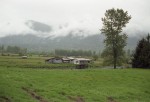Oct
26
2014
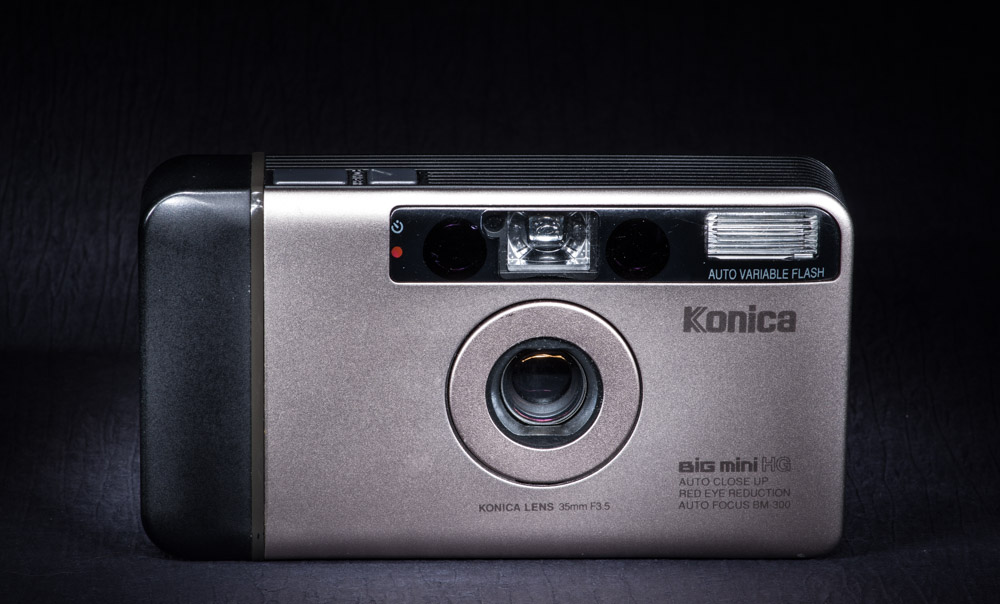
Question: What do you get when a camera isn’t fully advancing between frames?
Answer: Its worth a thousand expletives

I often get exactly what I deserve when I test old cameras that no one wants anymore. There may be a reason someone tossed that camera away but…
If the camera makes a whir I will not be deterred.
If the film will load I won’t be slowed.
I won’t quit even if the camera is shi.…… You get the idea.
no comments | tags: film, Konica | posted in Cameras, Photography
Oct
24
2014


I shot a roll of Cinestill 800T in my Minolta X700 mostly of very dark things with bright lights, what can I say I like the halo’s it creates (For an explanation of what and why see this post Niagara at Night with Cinestill). unfortunately the roll I had may have come from an early run before they say they improved the process or just a faulty roll. So most of the images on the roll have residual rem-jet coating that makes some of the images appear like you’re looking through a glass of Guinness Stout.

That part is a bummer because some of those images can not be redone but I emailed Cinestill and notified them and they offered to send me replacement rolls for my remaining film in case other rolls are similarly afflicted. Now you might be thinking well of course that is the right thing to do and I agree but for them to do it so quickly and without further hassle to me is what I consider excellent customer service (Pretty much the opposite experience of all the failed Apple charging cables I’ve had to contend with). With some editing I am able to minimize the impact of the rem-jet and salvage the images at least for the purpose of sharing but really what matters to me is that Cinestill re-established my confidence in shooting their film and I look forward to shooting even more of it.
Here are some of the better files from the roll with the faults more visible than others even after editing to minimize them.
1 comment | tags: Cameras, cinestill, film, Photography | posted in Photography, Processing
Oct
11
2014
It’s hard to say exactly what happened with this film because I have no idea what kind of film it was. Sure it was in a Konica roll but it was pretty evident that it had been re-rolled into it. The clues were that it appeared to be black and white film in a c41 process canister and that the leader looked like it was hand cut with pinking shears. So Right from the start it was an iffy proposition. I believe I shot it as if it were ISO 400 but it could easily have been a ISO 100 film who knows. There is some under exposure in that. I also shot it mostly at night under artificial light that’s not going to help things. And finally not knowing what film it was my friend took an educated guess at the developing but it looks like it might be under developed. All this resulted in such faint images on the film that you couldn’t discern if there was an image or not. Thanks to my Epson V700 though I was able to at least get enough of a few images to jog my memory of shooting that night. I seem to remember using a Pentax Spotmatic or K1000 but they are innocent in all this, its my willingness to try to take a picture with anything that is to blame.
no comments | tags: film | posted in Cameras, Photography
Oct
6
2014

What happens when you accidentally leave that little switch on the P on that cheap point and shoot film camera?


It wasn’t until I received my developed film that I realized that the little 28mm f3.5 lensed Nikon AF600 I had been using was set to panoramic mode for most of the roll. Through sheer luck or questionable compositions of putting the main subject in the center of the frame some of the images actually looked alright.
When the camera wasn’t set to panoramic mode it actually equated itself well photographically at least in the center of the frame. But like a room that hasn’t been vacuumed in a while it’s probably best not to look in the corners.

1 comment | tags: camera, film, Nikon | posted in Cameras, Photography
Sep
29
2014

I’m sorry Wallace I’m afraid I can’t do that.
That being scan APS film in its cartridge on a flatbed scanner. So my solution take a picture it lasts longer. Not everyone will have encountered APS film so here is a little recap. APS film is smaller than 35mm film and after developing and printing it is spooled back into its cartridge never to be seen again (That isn’t strictly true but when was the last time you took a roll of film in for re-prints). Okay re-prints are where….. this could go on for a while so forget all that. APS film in cartridge, needs scanning ect. ect.
The first thing that needs to be done is to get the film out of the cartridge. Start by removing the label 
Then crack the cartridge open  which will let you get at the little film nugget inside
which will let you get at the little film nugget inside  The images on film look like this at this point.
The images on film look like this at this point. 
Which may be cool and impress cell phone photographers but the orange mask necessary from optically printing the film makes everything look sickly not to mention the fact that the image is a negative. The next thing is to take the pictures of the film, in my case I’m using a slide duplicator, a flash and the Pentax DA 35ltd macro lens all of which you should have laying around (or not).
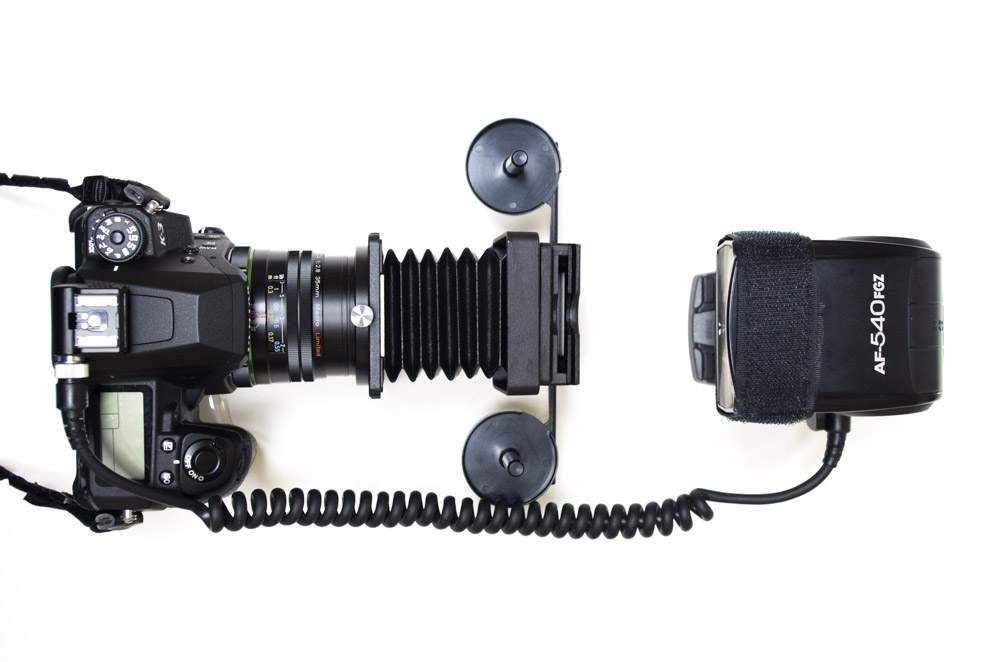
This yields a digital image that needs to be cropped and adjusted 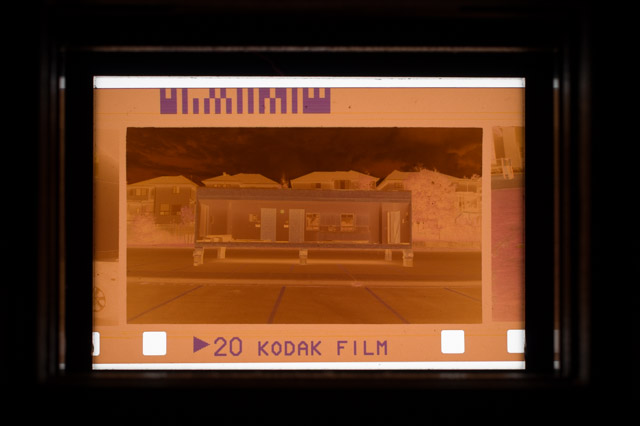 It will be a different process depending on what software you are using but it can be accomplished in Lightroom by going to the tone curve and dragging the two ends vertically to their opposite corners this has the effect of making the image a negative which it already is which makes it a positive which is good, simple right? The next thing to do is then to drag the colour balance down to eliminate what is now a cyan cast. After this its a basic matter of making adjustments to the image to make it look correct. I should add though that after the manipulation of the tone curve all the levels adjustments are reversed so things such as increasing exposure makes it darker, fun yes? After all that you should end up with an image that looks like this which will probably make you want to pick up a digital camera unless you feel photography should be a difficult process in which case carry on.
It will be a different process depending on what software you are using but it can be accomplished in Lightroom by going to the tone curve and dragging the two ends vertically to their opposite corners this has the effect of making the image a negative which it already is which makes it a positive which is good, simple right? The next thing to do is then to drag the colour balance down to eliminate what is now a cyan cast. After this its a basic matter of making adjustments to the image to make it look correct. I should add though that after the manipulation of the tone curve all the levels adjustments are reversed so things such as increasing exposure makes it darker, fun yes? After all that you should end up with an image that looks like this which will probably make you want to pick up a digital camera unless you feel photography should be a difficult process in which case carry on.

1 comment | tags: APS, film, Fuji | posted in Photography
Sep
10
2014


I didn’t end up finishing the roll of film in my Ricoh R1 so it did go through the security check at the airport and seems to have survived none the worse for all the radiation. As I’ve said before the Ricoh R1 has an incredibly sharp lens particularly in the center when set to 30mm not the 24mm wide angle seen in the picture above. It’s also small and pocketable. As it is one of the direct forerunners of the latest Ricoh GR digital camera its making me take a serious look at that camera too. We have reached a point in digital photography where there are many great cameras to choose from with each one having certain advantages that set them apart but they are for the most part all yielding quality images. So what would be the reason to use the R1 with film over buying a Ricoh GR? Well at around $800 for the GR that works out to around 80 rolls of film developed or 2880 frames so clearly in the long run digital would be an advantage but I’m not really likely to want to use this camera exclusively and 2880 frames might take me 5 years to shoot in that manner. You can see my dilemma, wanting something and needing it are two different things entirely.
no comments | tags: film, Photography, Ricoh | posted in Cameras, Photography, Uncategorized
Sep
5
2014


The Pentax smc PENTAX-DA 40mm F2.8 XS Lens is an impossibly thin pancake lens that was originally designed to go with the digital APS-c Pentax K-01 but as some people have noted it also covers a full 35mm film frame. I needed to find out for myself so I mounted it to my Pentax MZ-6 a camera that I had given away but received back and am very happy about that. I had really under rated the camera, while not built to take a beating like a professional camera, it has all the functionality of one. Back to the lens though. While the lens is very thin it shouldn’t be all that surprising as many 35mm film point and shoot cameras have similar sized lenses that are often even closer to the film plane. As a lens used with 35mm film I can say that it does an excellent job with very little vignetting which is the one thing you might expect to see when using an APS-c lens. The fact that it takes up next to no room in a camera bag and that it can be used on both film and digital really makes this a must carry lens for me.
2 comments | tags: film, lens, Pentax | posted in Cameras, Photography, Uncategorized
Sep
2
2014

It’s little cameras like this that remind me sometimes why I like film so much. The camera itself cost me next to nothing and even with the rising cost of film and processing if I shot 10 rolls of film a year with it (360 exposures) that would only amount to about $100 which is nowhere near what an equivalent digital camera would cost, that is if it existed. It has a fantastic 28mm f3.5 lens that is very sharp and contrasty. The extreme corners of the image do suffer and are not as sharp but all things considered it is possibly the best 28mm in a compact I have seen. The film I used in it was Kodak Ektar 100 which scans very well and creates very adjustable files. The single thing I like the most about this camera though is the manual focus settings. And the single thing I like the least is that any settings changes you make cause it to reset itself to auto flash where it fires more often than not. It may be shaped like a can of sardines but there is no denying it takes a quality picture. More info and pictures can be seen here Fuji Dl Super Mini
1 comment | tags: film, Fuji | posted in Cameras, Photography
Aug
31
2014

Niagara Falls seemed like a very gritty place to me, the city not the falls, the falls are wet. The grainyness of Adox Colour Implosion suits the place well. I loaded my Olympus XA with this film because it’s a great little camera to travel with. It’s small, reliable and gives good results. The images turned out to have a cool bluish cast to them from the Adox film but that too suits Niagara, at least when I was there at the end of April. Here is a closeup look at gritty grainy Niagara

no comments | tags: adox, c41, film | posted in Cameras, Photography
Aug
27
2014
What is bigger than an SLR but isn’t an SLR. A brick is bigger and the Nikon Zoom Touch 800 is too. So what do you get in exchange for carrying the biggest point and shoot film camera on the planet? Well an under whelming specified 37-105mm f3.7-9.9 lens. A big sticker that tells you that the lens has ED (extra low dispersion elements) is also provided. That’s a good thing because with a lens that slow and with such a limited zoom range it needs to provide some quality (the lens not the sticker). Besides being able to prop doors open with it, it also seems to work pretty well as a camera but it really is as big as an SLR.

2 comments | tags: film, Nikon | posted in Cameras, Photography


